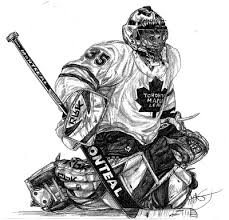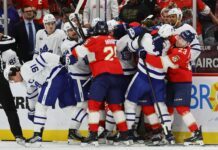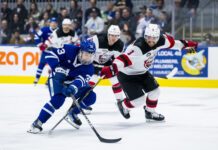 Almost had the title but Vesa ruined it.
Almost had the title but Vesa ruined it.
Let me preface this blog by saying goaltending talent and progression isn—t my scouting forte, but I—ve talked with other scouts and former goaltenders in an effort to better understand the position.
In an unrelated interview last season, former Rangers and Red Wings goaltender Ed Giacomin mentioned his disbelief of pure butterfly goaltending. He felt it wasn—t the way to develop younger goalies, rather for more established goaltenders to incorporate in a stand up style. Instead of staying on their feet and reacting to the play, the initial reaction is to drop to their knees and he went on to say it—s too easy for a struggling goaltender to drop as a reaction to the play, reverting to that technique instead of utilizing natural athleticism to react.
I—ve figured that it comes down to predictability with goalies. If shooters realize certain tendencies — and video scouting makes that easier — they will exploit them at every opportunity.
Ask poor Stephen Valiquette (another butterfly goaltender who—s natural reaction was to drop to his knees) of the New York Rangers, shell-shocked in the third period of a 10-2 rout by the Dallas Stars. The more the Stars scored, the quicker he was down in his butterfly as the period went on, and .. well the results speak volumes.
This problem was evident in the Leafs 5-2 victory over rivals, the Montreal Canadiens. Before Carey Price is crucified in the Montreal media, it should be noted he shares the same problem as Leafs prospect Justin Pogge and number one goaltender Vesa Toskala this season.
In Toskala—s case, there seemed to be a slight change in the mentality on Saturday night, but the other two goaltenders are having trouble despite spurts of exceptional play. Pogge seems to be in the best spot to correct this issue in the AHL (where perhaps Price should be working this out), although he is still using the same coach to work through these issues.
Both goaltenders fall to their knees way too early in their stance, reacting to the play, almost as a fail-safe, taking away the lower part of the net and becoming ˜big— to take away the space and angle. It isn—t so much goaltenders making saves, rather than relying on players hitting them with the puck. It—s very Raycroft-ian.
In Pogge—s case, this is a season-long phenomenon with the Marlies. TSN—s Bob MacKenzie was quick to point out last week during the Leafs/Sabres telecast that Pogge hasn—t done anything in the AHL to warrant a look in the majors, and it—s a sentiment I share, because of this technique among other factors.
The Buds didn—t really offer much help in his two blowout starts, but refer to Drew Stafford—s goal in Buffalo last week. Stafford undressed, then stepped by Mike Van Ryn, roofing a shot over Justin Pogge who was down on his knees way, way too early on that play among others. The puck hadn—t left Stafford—s blade before Pogge was on his knees leaving the upper part of the net exposed. Granted Stafford made an excellent play, but had Pogge stood his ground (be less predictable) the goal could have been avoided.
Four of the five goals on Price on Saturday were of the same variety; glove hand high — Blake should be sending him a box of chocolates — similar to the series against the Flyers in the Conference Semi-Finals last spring. The emotional — almost tear-inducing — interview after Saturday—s game focused on professionalism and ability to work harder.
And I scream hogwash. The kid has problems with the fact that he—s a pure butterfly goaltender and that style is his own determinant. The book is out and shooters know that he drops as a first reaction. He then stays down with a good ability to move laterally with slight movements off the toe of his skates covering the net. He won—t steal many games if he doesn—t find a way to recover quicker from initially dropping to his knees.
Patrick Roy, the pioneer of the modern-day butterfly (Glenn Hall used to use the style too, and was asked to stop), had a unique ability to go down fast, take the lower part of the net away and then recover using superior athleticism to augment butterfly skills.
He wasn—t stuck in the butterfly position after initially dropping and moving post-to-post ala Price, and he didn—t rely on the style to make him competitive. In the pioneering days equipment was heavy and goal pads retained water making them heavier. He had to figure out a happy medium to be successful, and he did. It—s what elite goaltenders do; combining athleticism and ability to hybrid styles making saves (see Evgeni Nabokov, Nicklas Backstrom, Martin Brodeur and Roberto Luongo)
As for Vesa Toskala, I think this is one of the main reasons he—s stinking it up this season. Watching the goaltenders at training camp being instructed by goaltending coach, Corey Hirsch, aside from basic technical and fundamental positioning, all three Leafs goaltenders were being taught to butterfly.
Toskala is not a pure butterfly goalie and shouldn—t be forced. Relying on athleticism and a modified hybrid style, it—s easy to spot holes appearing this season in relation to 2007-08. In the second half of last season (and in fact, all season), the goaltender relied heavily on a modified butterfly with floppy athletic style a la Boston goaltender Tim Thomas. Recovering from the initial fall to his knees, he was able to use athleticism and reflexes to make the impossible stops that grew his reputation as a marketable asset for the Leafs rebuild.
This season, off the hop, he dropped to his knees and tried to ˜be big—. This has hurt his overall effort and made him just as predictable as Carey Price and Justin Pogge.
Publicly lambasted by Leafs management on work ethic and lack of willingness to work on his issues, on Saturday he played one of his best games. Why?
He seemed to revert to his old acrobatic self. He flip-flopped around when he had to, and when he went back to the butterfly he was beaten like the Tom Kostopoulos tap-in for Montreal—s second goal, when the puck squirted off to his right and fell alone in the crease, while he was down on his knees in a butterfly crouch to the left side. The camera angle from inside the net showed this perfectly.
Add the mental aspect for a goaltender like Toskala, who relied on natural athleticism, thinking about the technique and reacting put him behind the count because instead of reacting naturally, he—s moving in a mechanical, predetermined fashion as per the coaching demands of the organization.
Tim Thomas has been successful in an unorthodox style because the B—s have let him develop that on his own.
This, to me, is not a direct reflection on any of these goaltenders abilities, but coaching issues. Before Leafs management start lambasting goaltenders publicly in an effort to light a fire, perhaps they should look internally and realize they—re hindering efforts and in the end, diminishing trade value (due to fundamental skills, not necessarily on sketchy performance) and in the end, their own return for the rebuild.
Burke had another butterfly goalie in J.S. Giguere but Ron Wilson saw what Evgeni Nabokov can do in a hybrid style.
While dropping down, goaltenders also have to rely on their defense doing their job and clearing pucks from in front of the goal, and controlling forwards driving to the net looking for rebounds. This double onus on rearguards stifles the momentum of a transitional attack allowing the opposition to set up on defense and taking away the element of speed across the neutral zone and in effect limiting odd-man rushes.
There are issues plaguing all three netminders. Goalies are difficult to read and my analysis could be off, but I believe they should remain unpredictable.
If they are ever to become an elite goaltender (Price), marketable trade bait (Toskala) and a goalie of the future (Pogge), they have to start using their natural skills more often and stop relying on the one style altogether.

































